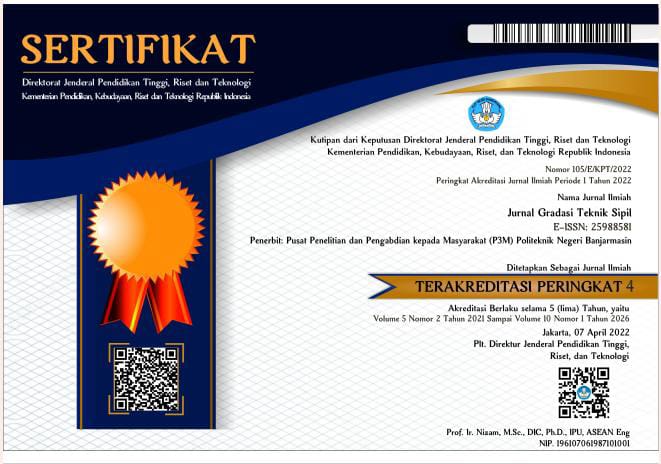Ekosemen Sebagai Media Perekat Pengganti Semen Untuk Beton
DOI:
https://doi.org/10.31961/gradasi.v2i1.557Keywords:
eco-cement, concrete, recycleAbstract
Waste is a serious problem faced at this time. A lot of pollution and diseases caused by waste, therefore many efforts are made so that waste can be utilized even contain economic value. One of the utilization of waste is as an eco-cement used as a substitute for cement.
This study used the concrete quality of the plan fc '= 10 MPa and fc' = 20 MPa, the making of concrete utilized waste ash in lieu of cement in predetermined quantities, waste ash obtained from organic waste and inorganic waste that was burned to ash and then filtered using 100 and 200 sieves. Variations of ash addition of 0%, 10%, 20%, 30%, 40% and 50% of the volume ratio. Age of concrete testing was 7, 14 and 28 days. The results obtained from the test indicate that the material used met a predetermined standard, with the variation of the concrete weight mixture of concrete unchanged. From the concrete strength test result for fc '= 10 MPa, the best concrete mixed variation is 20% with compressive strength equal to 12,76 MPa at 28 day age, fc = 20 MPa concrete quality with best mix variation 20% has compressive strength of 17.29 MPa, the largest compressive strength value compared with the compressive strength of concrete containing ash, the compressive strength difference of 13.8% lower than the normal compressive strength of the concrete, while the effect of each mixture variation on the age of concrete is linear; with the increase of the age, the compressive strength tends to increase.
Downloads
References
Frieska Ariesta S dan Dyah Sawitri. (2013). “Studi Eksperimental Pembuatan Ekosemen dari Abu Sampah dan Cangkang Kerang sebagai Bahan Alternatif Pengganti Semenâ€ÂJurnal Teknik POMITS, Vol. 2, No. 2., Jurusan Teknik Fisika Institut Teknologi Sepuluh November, Surabaya.
Idham, M (2014) Pemanfaatan Abu Sisa Pembakaran Sampah sebagai Bahan Stabilisasi Tanah, Penelitian Dosen Pemula, Jurusan Teknik Sipil, Politeknik Negeri Bengkalis.
Neli Susanti. 2009. Pembuatan Ekosemen Dari Abu Sampah Dan Uji Aplikasinya Untuk Panel Beton. Tesis. Sekolah Pascasarjana Universitas Sumatera Utara. Medan.
Nelvia Adi Syafpoetri, Monita Olivia, Lita Darmayanti.2012.†Pemanfaatan Abu Kulit Kerang (Anadara grandis) Untuk Pembuatan Ekosemenâ€Â. Tugas Akhir. Jurusan Teknik Sipil Fakultas Teknik Universitas Riau Pekanbaru.
Nunik, G. P. 2016. Pembuatan Ekosemen Berbahan Abu Cangkang Kerang, Abu Sampah Organik, Dan Lumpur Limbah. Skripsi. Program Studi Ilmu dan Teknologi Lingkungan. Universitas Airlangga. Surabaya.
Shinta Marito Siregar.2009.†Pemanfaatan Kulit Kerang Dan Resin Epoksi Terhadap Karakteristik Beton Polimerâ€Â.Tesis.Jurusan Fisika Sekolah Pascasarjana Universitas Sumatera Utara Medan.
Siswanti, N.,D., Nanda, R., dan Anggraini (2009) Pembuatan Ekosemen dari Sampah Organik, Jurnal Teknik Kimia, Vol. 3, No. 2, Jurusan Teknik Kimia UPN Veteran Jawa Timur.
T. Shimoda, S., dan Yokoyama. 2009. Ecocement-a new Portland cement to solve municpal and industrial waste problem, Proc. Of International Congress with Concrete, Dundee.
Wiradarma, L.W. 2007. Pemanfaatan Abu Sampah Padat Perkotaan (Municipal Solid Waste) Kota Mataram Sebagai Alternatif Bahan Stabilisasi Tanah Lempung, Vol. 3, No. 1, pp. 26-37.
Downloads
Published
Issue
Section
License
- Hak publikasi atas semua materi naskah jurnal yang diterbitkan/dipublikasikan dalam Jurnal Teknik Sipil ini dipegang oleh Dewan Redaksi dengan sepengetahuan penulis (hak cipta tetap dimiliki penulis).
- Ketentuan legal formal untuk akses artikel digital jurnal elektronik ini tunduk pada ketentuan lisensi Creative Commons Attribution-ShareAlike (CC BY-SA), yang berarti Jurnal Teknik Sipil berhak menyimpan, mengalih media/format-kan, mengelola dalam bentuk pangkalan data (database), merawat, dan mempublikasikan artikel tanpa meminta ijin dari Penulis selama tetap mencantumkan nama Penulis sebagai pemilik Hak Cipta.
- Naskah yang diterbitkan/dipublikasikan secara cetak dan elektronik bersifat open access untuk tujuan pendidikan, penelitian, dan perpustakaan. Selain tujuan tersebut, dewan redaksi tidak bertanggung jawab atas pelanggaran terhadap hukum hak cipta.








